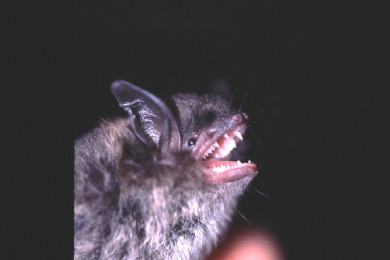Recent surveys for bats in New Hampshire hibernacula, places where bats spend the winter, resulted in biologists finding a total of only 28 bats, with two formerly very common species missing.
“White-nose syndrome has decimated little brown bats and northern long-eared bats,” said New Hampshire Fish and Game biologist Emily Preston. “Little brown bats were the most common species in the state before 2009.”
White-nose syndrome is a fungal infection that infects bats during the winter, while they are hibernating. It damages the thin tissue of the wing. That tissue helps the bats with temperature regulation, air exchange, water retention and flight. “Since bats are hibernating, their immune system is suppressed, so they cannot fight the fungus,” said Preston. The fungus causes the bats to wake up from hibernation much more frequently and stay awake longer. This burns through their stored fat too quickly, often times not leaving enough to survive the winter.
White-nose syndrome was first documented in New Hampshire in 2009 during normal winter surveys conducted by Preston, researchers Dr. Scott Reynolds and Dr. Jacques Veilleux, as well as US Fish and Wildlife Service biologist Susi von Oettingen.
One survey this winter found that a mine that previously had 514 bats with three species in 2009, now had no bats. Dr. Veilleux shook his head and said, “I can’t believe we’ve lost so many bats, so quickly. I had some small hope that we might see a bit of a recovery this year; it’s sad that we have experienced a near complete loss of our wintering bats, and really sad to think I likely won’t be around to witness a possible recovery of these populations.” Since bats generally have only one pup a year, it will take many decades for the population to rebound, if they ever do.
Overall, over 90% of little brown and northern long-eared bats in the Northeast have been killed by this disease. The disease has now spread to 23 states and 5 Canadian provinces, killing millions of bats.
Not finding little brown or northern long-eared bats in hibernacula does not mean those species are gone from the state. N.H.’s summer bats fly to hibernacula in Vermont and New York also. “We monitor a couple of little brown bat maternity colonies. These are places where female bats raise their pups. So far, these still have bats and they are producing pups,” said Preston. Maternity colonies in barns and homes are also monitored by homeowners under a citizen science program run by N.H. Fish and Game. Homeowners simply go out at dusk and count the number of bats that exit when it gets dark enough. The survey takes about 20 minutes and details on how to do this, as well as more information on N.H. bats, are found on the Fish and Game website at http://www.wildlife.state.nh.us/Wildlife/Nongame/bats.html.
Source: New Hampshire Fish and Game Department press release


Would you please contact me via Email.
I have a lovely photo to share with you!
We have a Little Brown Bat nursery.
I’m pretty sure its the Little Brown Bat!
Okay its not very big, there appear to be 8 bats… 4 moms and 4 pups? They patrol my deck and come quite close to us scooping up the mosquitoes. I am NOT having them removed!!! They are free to continue to live in harmony with us serenading us with their clicking in the morning and at night!
I looked for the Citizen Science program survey and was unable to locate it. I would like very much to share my info with whomever could benefit. We also have two huge bat houses on the back of our garage. One has guano under it so I know it is inhabited. I wonder if perhaps that is the usual nursery and they were full up and some of the moms had to find alternate shelter. They were fussing this morning and I went out to check on them, wondering if some animal was molesting them. They were fine. I think the space is getting a bit tight for moms and babies and the day was heating up. I think they must be like us and get a little grumpy when it gets too hot. They were all peeking out when I looked at them. All their cute little heads showing. My niece took the picture. lol She was creeped out she said but she’s somewhat talented with photography (though it was a challenging shot to take in this case). So she started clicking away. And just so you know… they do NOT appear to have the white-nose syndrome! They all look clean and healthy. The picture shows them so clearly that you can that several of them have tongues sticking out (perhaps a response to the heat??)
Hi, you can share this observation, and any others, with iNaturalist Vermont (if in Vermont) or iNaturalist anywhere in world. Just visit http://www.inaturalist.org/projects/vermont-atlas-of-life and add your observations!